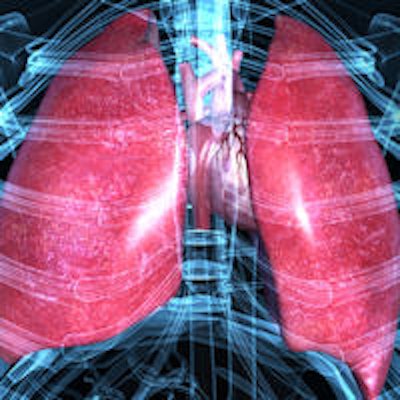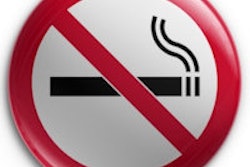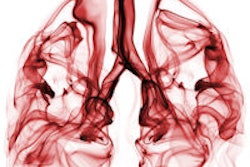
A fast, low-cost test that analyzes the chemical composition of exhaled breath may confirm that patients are disease-free after lung cancer resection, concludes a study published this week in the Annals of Thoracic Surgery. The test could provide a noninvasive way of monitoring lung cancer patients after surgery.
Researchers from the University of Louisville in Kentucky performed a quantitative analysis of four exhaled carbonyl compounds (ECCs) in 187 control subjects and in 34 lung cancer patients who were tested before and after lung cancer resection. The results showed that median compound values tested after resection were significantly lower for all four ECCs and were equivalent to control patient values for three of the four compounds.
"The analysis of ECCs demonstrates reduction to the level of control patients after surgical resection for lung cancer," wrote Dr. Erin Schumer and colleagues. The technology could be a useful tool to detect disease after lung cancer resection, according to the group.
CT alone has shortcomings
Despite significant improvements in lung cancer diagnosis and treatment, overall survival for lung cancer remains low -- at 18% -- over five years, much lower than survival for other cancers. While lung cancer screening with low-dose CT showed a 20% reduction in lung cancer mortality, the test still produces plenty of false-positive findings, which were experienced by one-fourth of all participants in the National Lung Screening Trial (NLST).
The deficiencies of low-dose CT lung cancer screening offer opportunities for improvement in lung cancer detection and the development of alternative diagnostic strategies, the authors wrote. More specifically, a diagnostic method that could contribute to surveillance after lung cancer resection would be ideal, inasmuch as recurrence happens in up to 20% of patients and 7% experience a second primary recurrence.
Analyzing the chemical composition of exhaled breath could provide a surveillance mechanism for patients after resection of diagnosed lung cancer, and its utility has been demonstrated in previous research. A 2015 study in the Journal of Thoracic and Cardiovascular Surgery by the current authors found that analysis of exhaled carbonyl compounds had the ability to detect lung cancer. Also, in 2014, Fu et al and Bousamra et al used ECC levels to distinguish benign from malignant disease, potentially providing a screening examination with the analysis of four exhaled carbonyl compounds: 2-butanone, 3-hydroxy-2-butanone, 2-hydroxyacetaldehyde, and 4-hydroxyhexanal.
The current study looked at changes in the levels of exhaled carbonyl compounds after resection of malignant nodules. The researchers compared the results with those of healthy controls with no history of lung cancer to determine whether ECC levels would normalize to background levels after resection.
The study team collected 1 L of breath from 222 subjects, with pathological confirmation of lung cancer in 31 patients and benign disease in four. After resection, a similar sample was collected from the lung cancer patients. The four carbonyl compound gases analyzed were 2-butanone, 3-hydroxy-2-butanone, 2-hydroxyacetaldehyde, and 4-hydroxyhexanal. The exhaled gases were collected on specially designed microchip pillars and analyzed using mass spectrometry, Schumer and colleagues wrote.
A positive carbonyl marker was defined as being at least 1.5 standard deviations greater than the mean of the control population, they wrote.
Gases back to normal after resection
The researchers found no significant differences between the cancer patients after surgery and the control group in the median concentrations of three of the four gases: 2-butanone, 2-hydroxyacetaldehyde, or 4-hydroxyhexanal (p < 0.05). The postresection concentration of 3-hydroxy-2-butanone in the cancer patients was significantly higher than in the control group. However, median concentrations were significantly lower for all markers after resection in the 31 patients with lung cancer.
"The lack of consistent normalization of 3-hydroxy-2-butanone after resection suggests that this compound may be tied more closely to inflammation associated with tumors rather than the tumors themselves and, thus, may remain elevated longer after resection," the authors wrote. They noted that further studies to identify the mechanisms involved in the production of carbonyls and their relation to other cancers will help answer remaining questions.
This study did not show sensitivity, specificity, or positive or negative predictive values, which will be needed to evaluate potential use of the technology and receive clearance from the U.S. Food and Drug Administration.
Still, surveillance using breath analysis "has the potential to offer patients a less-expensive, more-convenient test that avoids radiation exposure," Schumer and colleagues wrote. Yet much remains to be learned about the technology, because although ECCs "are clearly associated with malignancy, the mechanism of their formation is still unknown."
Breath analysis "may be useful as a potential tool after lung cancer treatment," the authors concluded.
Future studies will determine the ability of breath analysis to detect recurrent disease and will help determine its role in lung cancer surveillance after resection.




















